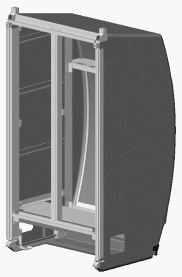International Standard Payload Rack

The International Standard Payload Rack (ISPR) has been adopted by the International Space Station (ISS) program to support efficient integration and interchangeability of payload hardware – and to maximize joint research among investigators. The 37 ISPR slots for science payloads on ISS provide a common set of interfaces regardless of location. Nonstandard services are also provided at selected locations to support specific payload requirements.
Capabilities
Each ISPR provides 1.571 m³ (55.5 ft³) of internal volume being about 2 m (79.3 in) high, 1.05 m (41.3 in) wide, and 85.9 cm (33.8 in) deep. The rack weighs 104 kg (230 lbm) and can accommodate an additional 700 kg (1540 lbm) of payload equipment. The rack has internal mounting provisions to allow attachment of secondary structure. The ISPRs will be outfitted with a thin center post to accommodate sub-rack-sized payloads, such as the 483 mm (19 in) Spacelab Standard Interface Rack (SIR) Drawer or the Space Shuttle Middeck Locker. Utility pass-through ports are located on each side to allow cables to be run between Racks. Module attachment points are provided at the top of the rack and via pivot points at the bottom. The pivot points support installation and maintenance. Tracks on the exterior front posts allow mounting of payload equipment and laptop computers. Additional adapters on the ISPRs are provided for ground handling.
Other ISPR systems
Japan has developed an ISPR with interfaces and capabilities nearly identical to NASA's.
